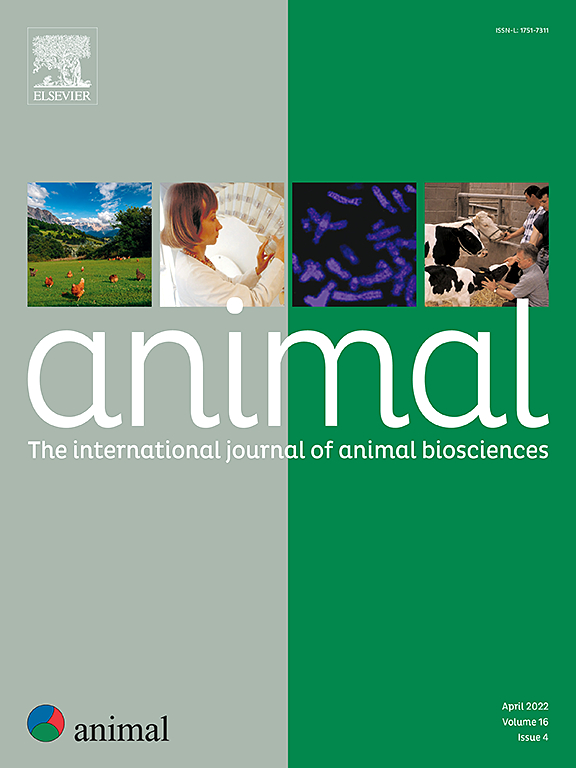农民在有机奶牛场实施奶牛-小牛接触系统的经验
IF 4.2
2区 农林科学
Q1 AGRICULTURE, DAIRY & ANIMAL SCIENCE
引用次数: 0
摘要
大多数人都不知道奶牛和小牛出生后不久就分开的常见做法,当被告知时,往往对这种做法持负面看法。为了更好地反映奶牛和小牛的自然行为,一些奶牛场正在开发替代系统,使奶牛和小牛之间的接触时间比传统的出生后立即分离更长。这种牛-小牛接触(CCC)系统并不普遍,但对农民来说正变得越来越重要。这项工作的主要目的是描述性地探索成功的CCC系统在奶牛场的实施策略,并发现被采访的农民认为可能的驱动因素和障碍。为此,我们访问了德国南部19个运行CCC系统至少2年的农场,并使用标准化问卷对他们进行了采访。我们发现了范围广泛的CCC系统,其实施方法因农场而异。考虑到动物福利和减少工作量是推动实施的主要因素。接受采访的农民认为在分离过程和谷仓空间要求方面存在挑战。能否成功,即过渡到共同承担责任的系统并在较长时间内运作,似乎取决于农民的信念、创造力和管理技能,以克服感知到的障碍。犊牛饲养的进一步发展应考虑到提高动物福利的社会利益。本文章由计算机程序翻译,如有差异,请以英文原文为准。
Farmers’ experiences of implementing cow-calf-contact systems on organic dairy farms
Most people are unaware of the common practice of separating dairy cows and calves shortly after birth, and when informed, often have a negative view of this practice. To better reflect the natural behavior of cows and calves, some dairy farms are developing alternative systems that allow longer contact between cows and calves than the conventional separation immediately after birth. Such cow-calf-contact (CCC) systems are not widespread but are becoming increasingly important to farmers. The main objective of this work was to descriptively explore the implementation strategies of successful CCC systems on dairy farms and to detect possible drivers and barriers as perceived by the farmers interviewed. To this end, we visited 19 farms in southern Germany that had been running CCC systems for at least 2 years and interviewed them using a standardised questionnaire. We found a wide range of CCC systems with implementation methods varying considerably from farm to farm. Animal welfare considerations and reduced workload were the main drivers for implementation. The interviewed farmers perceived challenges in the separation process and space requirements in their barns. The success, i.e. transitioning to a CCC system and operating it for a longer period, seemed to depend on the farmer’s conviction, creativity and management skills to overcome the perceived barriers. The further development of calf rearing should consider societal interests which are increasingly demanding for improved animal welfare.
求助全文
通过发布文献求助,成功后即可免费获取论文全文。
去求助
来源期刊

Animal
农林科学-奶制品与动物科学
CiteScore
7.50
自引率
2.80%
发文量
246
审稿时长
3 months
期刊介绍:
Editorial board
animal attracts the best research in animal biology and animal systems from across the spectrum of the agricultural, biomedical, and environmental sciences. It is the central element in an exciting collaboration between the British Society of Animal Science (BSAS), Institut National de la Recherche Agronomique (INRA) and the European Federation of Animal Science (EAAP) and represents a merging of three scientific journals: Animal Science; Animal Research; Reproduction, Nutrition, Development. animal publishes original cutting-edge research, ''hot'' topics and horizon-scanning reviews on animal-related aspects of the life sciences at the molecular, cellular, organ, whole animal and production system levels. The main subject areas include: breeding and genetics; nutrition; physiology and functional biology of systems; behaviour, health and welfare; farming systems, environmental impact and climate change; product quality, human health and well-being. Animal models and papers dealing with the integration of research between these topics and their impact on the environment and people are particularly welcome.
 求助内容:
求助内容: 应助结果提醒方式:
应助结果提醒方式:


